Posted December 4, 2016
By BRITTANY CHANDANI
DELHI — As I stepped off of the plane and into the Indian heat, I realized just how far from home I was. The 20 hours of watching in-flight movies finally led up to a trip I had waited all year for. India would be my home for the next month as I traveled through the big cities of Delhi, Jaipur and Agra, as well as the small city that is my father’s hometown. On no other trip had I experience such a cultural shock, a new appreciation of history and an inner peace too profound not to mention.
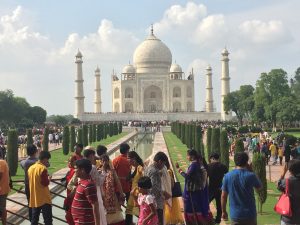
The Taj Mahal (Photo by Brittany Chandani).
The reasons to visit India are endless. It the birthplace of Hinduism and Buddhism, it holds one of the Seven Wonders of the World: the Taj Mahal and it shows humanity at its rawest level, leaving you grounded.
However, I also learned that there are certain cultural cues that must be followed— and navigating them are much less difficult than navigating India’s unpaved roads. It is important to follow these guidelines, not only for your own safety but also as a respect to the beautiful culture that surrounds you.
The culture shock once you step off of the airplane is an assault of all senses— from the way people dress to their gestures and even their bathrooms. This cultural clash should be met with an open mind. You are now in a whole other land with a whole other language and culture that dates back to the beginning of time.
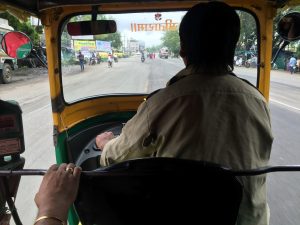
Inside a rickshaw (Photo by Brittany Chandani).
India is home to sensory overload! The smells of earthy dirt, the sights of raw natural beauty, the sounds of blaring car horns, music and foreign chatter—they come together to fill the street and your head.
It is easy to get lost in it all, but visiting a local temple will clear the clutter. You will be surprised at the daily flow of Indian life. India is a go, go, go kind of country, and it shows in the bustling crowds that you will pass through and the even busier streets.
While traveling through towns, you will see that India is home to one of the biggest disparities of wealth in the world. In front of an intricate and large mosque, one can observe rows of tents no more than wooden sticks holding up plastic roofs. These are homes.
Nothing can prepare you for the feelings you will encounter upon seeing children picking through piles of garbage much taller than they are, scavenging for something useful. Valentina Quiroga, a graduate student at Florida International University, went to India last year and was shocked most by the way the middle class lives—“that there really is no middle class.”
However, India’s people are wholehearted and hospitable. They want to show you the beauty of their country while you visit. They are excited to see newcomers and may even ask to take a picture with you.
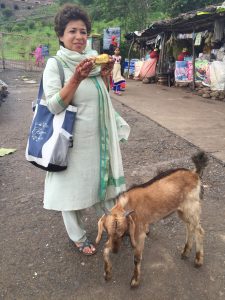
Visitor eating street food, being followed by goat (Photo by Brittany Chandani).
While visiting my aunt in India, who lived in a small clay home that was no larger than my living room, I was greeted with the hospitality one would find at The Ritz-Carlton.
She greatly anticipated my visit, preparing traditional Indian sweets, like kaju katli and sheera, as we sat sipping chai tea looking at old photos of our family. It was humbling to see someone who had much less than all of the people I knew back home offer me everything she could. This is why India is a place to be respected.
To show respect, dress conservatively— this means covering up from your legs to shoulders. Using your left hand to greet people is commonplace in the United States, but a cultural taboo in India. Eating with your hands is disapproved of in the United States, but is the norm in India. Look at what the locals do, as this will be your best guide.
When in India, you must visit at least one temple. Before going, be sure that you are dressed appropriately and be ready to experience a cultural clash right in front of you. Women must dress with their head and shoulders covered and wear long pants— no matter how hot it is outside.
I visited a very traditional Indian temple, in which I left my shoes out front as Hindu priests placed flower shawls on my shoulders and stuck ash and rice to my forehead. I was instructed to walk around three idols seven times all while repeating “Hari Krishna.”
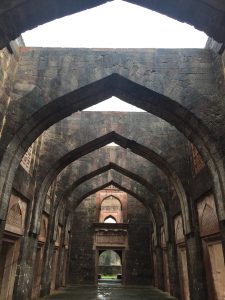
Indian monastery (Photo by Brittany Chandani).
Dressing conservatively is a sign of respect to the religion, and if not followed, may incur some bad attention or you may even be turned away. I wore traditional Indian clothing during the trip— it is the best way to ensure that no problems will occur. Indian clothing is lightweight, makes for great pictures, and makes you fit in much better since you will not have to worry if your pants are too tight or top is too see-through. You must also remember to remove your shoes before entering.
Simran Vohra, a university student in Mumbai, said that dressing conservatively is a big issue but only in smaller areas of India and that dressing in Mumbai, a big city, is much more relaxed.
“You can wear whatever, but again it all depends on the place you visit because the typical mentality in India is that a girl should be covered,” Vohra said.
“The custom in India is that you should cover your head while in temple or wear Indian clothes and you should remove your shoes and if you are on your period you shouldn’t visit temple.”
Vohra recalls once when a girl forgot to remove her shoes before entering a temple and “everyone was kind of angry.”
If visiting a community or family, there are gestures for respect that should be followed.
Vohra explains that you must “bow your head in Hindu communities and take the blessings of elders and parents.”
While there are lots of rules to follow, the experience of visiting India is quite safe and quite extraordinary. Vohra recommends attending a festival or visiting the Kerala Garden for peace of mind, or being a part of a wedding celebration.
In India, 22 percent of people live below poverty line— and poverty line is described as $1.25 per day on purchasing power parity. While the majority of Indian people are honest, some are driven to theft in order to make ends meet. As a result, tourists must be low key, trying not to flaunt wealth if in a poorer area. There are pickpockets in the street, so always be aware of your surroundings and hold onto your items while in transit. Know where your local embassy is in case of emergency, like a stolen passport.
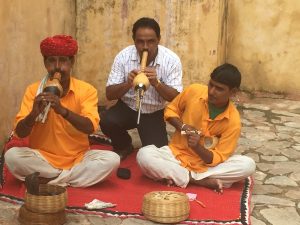
Snake charmers (Photo by Brittany Chandani).
I remember when passing through a toll gate, a group of men stood outside our car with a monkey. They made the monkey do tricks and then demanded money for it, but as soon as you opened the window they would reach in and grab your belongings.
Remember that, as a tourist, you stand out already in a mostly homogeneous people. Bringing on any other attention is easy and may have consequences.
Remember that you are in a country with a completely different set of rules. There is much emphasis on the separation of men and women. Western greetings and gestures like eye contact and smiling seem friendly to us, but inviting to some Indians. Some Indian men tend to see Western women as more provocative due to these gestures and also because of Western movies, and they may try to make advances because of this. It is important to realize that this is their culture and make changes in order to better fit in.
As a woman, keep a distance from men and try not to go anywhere alone. Be conscious of your surroundings and listen to your instincts. If something does not feel right, find a hotel or restaurant stay there until the suspicious people have left, or call your hotel to send a taxi.
Traveling at night is a bad idea, especially if you are alone or a woman. But if you must, be sure to have all of your hotel information written somewhere to show your driver. Airport drivers will overcharge you. Be weary of this and try to research prices before you go, or ask around and see what seems right. However, if you have a gut feeling not to go with someone, you are probably right. Find someone else, or better yet, call ahead to schedule a hotel shuttle.
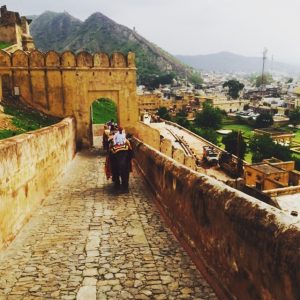
Elephant rides (Photo by Brittany Chandani).
India’s Foreign Office advises against females traveling alone or using public transport, like taxis or rickshaws at night. Instead, order a taxi through the hotel or at an airport counter as these taxis are more reliable.
Quiroga stayed with an Indian family and learned to live in a more traditional way—from eating with her hands to dressing like a true Indian.
Her biggest piece of advice for future travelers was not to rent a car— which is understandable as driving in India is quite impossible if you have not been raised on the system of avoiding sacred cows and driving up hilly, sinuous dirt roads. No matter how difficult the journey, a truly beautiful destination is waiting to be explored.
